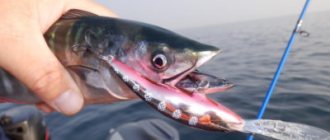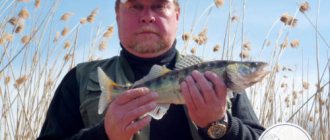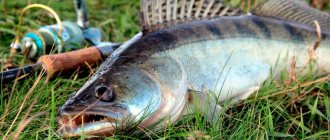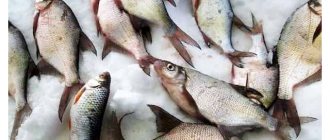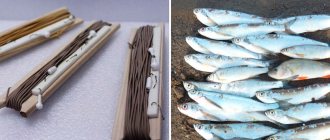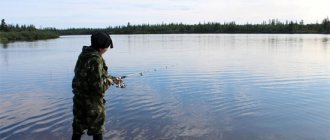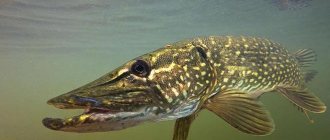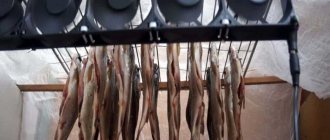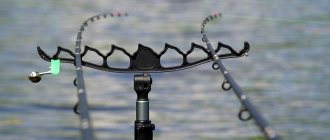Gear used for fishing
Tackle for pike perch for live bait fishing is selected taking into account fishing conditions, characteristics of the reservoir, time of year, possible sizes of expected prey, and also guided by the personal preferences of the fisherman.
Using this method, this predator is caught all year round, even in winter, from the ice. But what gives an angler special joy is catching pike perch in the spring, using live bait or any other bait. During this period, this predator noticeably becomes more active after winter stagnation. Expert opinion Nikolay Mikhailovich Knipovich Zoologist, hydrobiologist
I am interested in fishing at a professional level.
Attention! After the first fish you catch, stay in this place further. Pike perch, as a rule, does not walk alone; somewhere nearby there are other members of its flock, which can also get caught on your hook.
Select tackle for catching pike perch with live bait in the spring, when the ice has completely melted and nature has come to life, depending on the place where you will be fishing. If this is a large body of water, a large lake or reservoir, and a predator is walking there at a distance from the shore, then it is rational to think about hunting it from a boat. Hunting for pike perch from a boat with live bait on a large body of water, especially if the angler knows the places where it lives, can be crowned with a rich catch, and, most likely, you will not come across small fish in such places.
To catch a predator using live bait, the following methods are most often used:
- On a float rod. In this way, small pike perch are usually caught at the edge of the shore or from a boat at shallow depths. The Bolognese fishing rod is best suited for this. It will be easy for her to control the tackle and catch prey.
- With bottom tackle in all its variations: imported tackle with a rubber shock absorber, a regular donka, a feeder, etc. This is how it is usually caught in the summer and autumn, when it goes to the depths.
- Zherlitsy. This simple tackle, which in most cases looks like a slingshot with a fishing line wound around it, works well when catching pike perch with live bait in the current. It could be a small river or erik.
- Mugs. This is a close relative of girders, but they can only be used in bodies of water without a current.
In addition, some anglers like to catch this predator in a vertical line, using picker rods or strong winter fishing rods.
Expert opinion Nikolay Mikhailovich Knipovich Zoologist, hydrobiologist
I am interested in fishing at a professional level.
Attention! When fishing with girders, it is very convenient to use a boat to install and remove them. With its help, girders can be installed in the most secluded places, inaccessible from the shore.
Perhaps the most popular is fishing for pike perch using live bait on a feeder, although many fishermen associate this method only with catching white, peaceful fish. With the help of this gear, it is caught most of the year, on almost any body of water, when pike perch is caught with live bait from the shore and a good cast is needed. This is where the feeder rod will show its best qualities.
Feeder equipment for catching pike perch with live bait is not much different from the classic version. Also, as the main load, you can use a feeder with bait for white fish; it will additionally attract other fry, only the leash should be stronger and live bait should be attached to the hook, and not a worm. This method is equally effective for catching predators with live bait both in the current and in almost stagnant water, in backwaters.
Catching pike perch with an elastic band, how to make your own tackle
Catching pike perch using equipment such as an elastic band was in no way included in the category of sports gear.
But with all this, this equipment allows fishermen to provide a fairly significant catch, especially when all the elements are selected correctly.
Therefore, let’s look at what this equipment is and what it should be used with when fishing for pike perch.
What is this gear?
This elastic band is a type of donkey, but the main difference here will be the fact that the distance between the main fishing line and the sinker element is occupied by several meters, the so-called rubber shock absorbers.
This connection provides great stretch, allowing anglers to remove hooks without having to re-throw the load multiple times. The presence of this elastic band quite significantly softens the processes of all kinds of jerking actions carried out by pike perch when fishing.
Pike perch is caught using so-called live bait. In this rig, it is better to use weights that resemble olives in shape. It is necessary to choose a sinker that the elastic band itself can pull out.
In this rig, you should use a leash, because if a pike bites, it may simply bite off the fishing line. Thinner leashes should be used. Tees are used, as for catching pike perch in a vertical line.
How to make this gear yourself?
Many people wonder how to properly make a rubber band for catching pike perch? The manufacturing process of this equipment for catching pike perch is quite simple, so it is possible to make it at home independently. In addition, it can be collected right on the shore before fishing, but this takes quite a long time.
Initially, you should measure the fishing line material, which will vary in length from fifteen to fifty meters, depending on the distance the fisherman is going to throw this gear.
At one end you need to tie a loop where the cord itself with the sinker will be attached. At twenty centimeters you should make a small loop to secure the leash.
At a distance of every thirty or forty centimeters, four more loops should be tied.
You should tie a sinker to the end of the rope, and create a loop from the other end. When using a rubber shock absorber, the fishing line and nylon cord are secured. You should use connecting washers. The process of mounting the leash should be carried out after mounting all the equipment at the catch site.
It is necessary to carry out the process of winding the fishing line onto a reel mounted on a pin or stick, which must be stuck into the bank. To signal bites, the most common small bell is used. In addition, to facilitate the search for the sinker, you should mount a small float on it.
This float is made in such a way that it is positioned using a long cord attached to a sinker. As can be seen from the above, the installation process itself is quite simple, so even a non-expert in fishing can cope with it without much difficulty.
What are the best baits to use when fishing for pike perch?
When carrying out a fishing process aimed at catching individuals of the carp family, fry of any fish should be used.
For a better fishing process, greater attractiveness for pike perch and an increased amount of catch, you should use live fry or small fish, you can, of course, use dead fry, or try to catch pike perch with an elastic band with artificial bait, but this will have a noticeable effect on the degree of attractiveness bait
When mounting these fry baits, hooks called tees should be used. The baiting process should be carried out in such a way that you need to hook the bait on the lips or on the back of the fry.
In order to maximize the life of the fry that are used as bait, you should use special cages made with small cells so that they do not escape.
Or you should use a regular five-liter container, which should be cut off and filled with water from the reservoir, and then let in the fry used for live bait.
How to choose a place to catch pike perch with an elastic band?
When fishing with equipment such as a rubber band for pike perch, it is enough to correctly select the area of the reservoir. Basically, you should look for such places in areas of the reservoir where there are a lot of small fish, which are the prey of individuals of the pike perch family. Catching pike perch in June most often begins with this method of fishing for a predator.
A more promising habitat for small prey for this fish are areas of reservoirs with shallow water depths, which means that the pike perch itself may appear there. There should not be too strong currents.
In addition, pike perch themselves need a variety of shelters, and they hide in various holes and pools.
They can use various thickets of vegetation, bushes, and tree debris as their shelter.
The best place for fishing for pike perch with a rubber band from the shore will be a small island, behind which there is usually calm water. In these places there may be sandbanks that abruptly turn into a pit. The most ideal options would be the fact that in this place there will be some kind of tree or snag.
With this method, it would be better to carry out the processes of catching pike perch with an elastic band from the shore in the evening, or to fish at night. But during the day you should look for this fish in its shelters.
Technique for catching pike perch with an elastic band
When catching pike perch, anglers themselves tend to use a rubber rig rather than a feeder. When caught with a rubber band, you should cast once. And then only the fishing processes should be carried out, as well as the process of replacing the bait itself.
Basically, the casting process should be done while using a boat. But if you carry out this process manually, then you should unwind the elastic band and fishing line from the reel and lay it out carefully on the shore. The process of attaching the sinker is carried out, and only then the actual casting of the same sinker. It is necessary to wait a little so that this load sinks to the very bottom.
The casting itself is carried out over the current. Several slingshots should be made, the first one should be installed on the bank and the slingshot should be secured.
The next one must be positioned so that it is between the loop and the elastic band. Next, the elastic is pulled out and the loop is attached to the slingshot.
The process of securing the leashes is carried out and the bait is planted. Then the line is released.
Technique for landing pike perch
When carrying out the biting process, a fish such as pike perch completely swallows the bait used, and then the process of quickly swimming out of this area occurs.
When a pike perch bites, a characteristic bell rings, which means the fish has taken bait and is trying to escape from the hooks. But the rod, stuck into the ground to secure the equipment, prevents the pike perch from breaking off the hooks.
In addition, that rod will not provide the necessary tension necessary for the fish to break the equipment.
Now comes the favorable moment for carrying out the processes of fishing for the caught pike perch. With this action, you should not in any way extinguish the activity of the pike perch’s resistance.
It would be better to just wait until the fish kicks and gets tired and then calmly fish. And here you cannot do without such a device as a fishing landing net, especially if you come across a fairly large pike perch. Or you can take advantage of the presence of a hook for this fishing.
The process of catching pike perch using rubber bands is quite difficult, and therefore few anglers like it. But the catch with this method of fishing can be brought home quite weighty and numerous, which you won’t be ashamed to show off to your fellow fishermen.
link:
Partner recommendations
Source: https://severtexno.ru/lovlya-sudaka-na-rezinku.html
Active elastic band
In the first case, you should play with bait, imitating a fry. By using the stretches and pauses that the elastic allows you to do, you provoke the predator to bite. In this case, various decoy baits are mounted on the hooks. They started with the semblance of twisters cut from rubber gloves, “cigarettes” - foam plastic in the shape of an elongated fish, shiny sparkles made from nickel-plated antennas, or simply equipped the doubles with “Campbrick” - insulation from wires and red thread. Afterwards, more and more often, fishermen began to replace home-made baits with ordinary twisters. It was in vain that the “cigarettes” were forgotten, which played interestingly in the water, floating up during a pause, and the “cambrics” were quite catchy.
The active method is very catchy, and comes to the fore from the beginning of June, when the pike perch has spawned and begins to feed. The whitebait is growing up, and the perch is going on a massive hunt. Pike can also be caught well this way. When fishing for it, you should make leashes from thick fluorocarbon, or, in extreme cases, use steel ones. The use of steel leashes is not recommended, because the game of bait changes. It becomes more enslaved and less interesting, keep this in mind.
The “rubber band” must be installed at a moderate current. In standing water, the tackle does not open fully and does not play properly. In addition, fish in still water attack the bait more selectively. During the current this happens much more aggressively and willingly.
To install gear on a predator, choose sandy or pebbly soils. Exits to spits, places where a reverse current forms, entrances and exits from pits, especially near which there are snags, work well.
When catching night pike perch and perch, also pay attention to the riffles, where it goes out at dusk to feed, and the pool behind them
Features of fishing with an elastic band
The peculiarities are that when fishing from a boat and the shore, with or without a current, it is necessary to change tactics:
- Fishing on the current. It is necessary to cast at an angle of 50 degrees to the current. This is explained by the fact that during the fall the tackle will be carried away. And the final place of its fall will be slightly lower than the casting point. The current will pull the tackle in the shape of a parabola, and if you cast in a perpendicular direction from the shore, the first hooks from the fisherman will lie in the shallows. The same applies to complementary foods; they need to be fed “in advance” of the current.
- Fishing in still water. In the absence of current, the cast must be made strictly perpendicular to the shore. This will ensure maximum coverage of coastal depths. It is preferable to use an active fishing method. Since the fish can ignore the bait lying calmly on the bottom.
- Fishing from a boat. It is carried out both in current and in still water. The difference is that the tackle with this fishing method plays the role of an elevator. The load is located under the boat, the tackle is reeled up. Thus, the fisherman gets the opportunity to fish all layers of water at the same time. Small changes are also made to the design of the elastic band. A safety line is tied to the sinker, the thickness of which is comparable to the main one. It is either tied to the side of the boat, or a large foam float is mounted on its end, and released with the flow. Insurance is needed to remove the rubber shock absorber along with the load to avoid premature wear and tear. Only then does it make sense to feed the fish. When you are fishing in a body of water with no current. Carry out feeding around the boat, throwing bait balls at a radius of one and a half meters. It is also necessary to throw several large lumps directly under the boat.
- Catching peaceful fish. To do this, the tackle must be equipped with leashes made of thin fishing line, the hooks must correspond to the size of the fish being caught. A large amount of bait will be required, which will need to be scattered evenly over the entire length of the main line. Follow a simple rule: what’s in the food comes on the hook. If the components of the bait include corn or peas, then you should bait them with at least 2 - 3 hooks. Fishing a peaceful fish with an elastic band requires some skill; you need to learn how to hook it instantly. Unlike a predator, a peaceful fish, having pricked itself on a hook, immediately moves away.
- Catching a predator. To do this, you need to install leashes made of thick fishing line on the tackle, or, as mentioned earlier, use special leash material. Choose bait, live (fry) or artificial (vibrotail, twister), you can combine baits. Use special double or offset hooks. Set the bait and start fishing. It would be more correct to use an active fishing method.
How to use the tackle
If everything is good, then we pull the tackle out of the water and fasten the leashes with simulator spinners, loop to loop, or with a carabiner, starting with the outer one. We put it into the water, making back-and-forth movements of the tackle with our hands, checking the hooks. Before starting fishing, many fishermen generally check the bottom of the fishing area with an anchor to avoid snags. In the final phase, the elastic band should be moderately stretched so that you can make back-and-forth movements with the fishing rod tied to the main line.
After the last leash has disappeared into the water, we stop the fishing line on a short, approximately 25-30 cm fishing rod or in a slot at the end of a thick branch, and fix it with a piece of rubber tube put on the main fishing line. From attaching the fishing line on the poke to the fishing rod, there should be about 2 meters of free fishing line left for twitching the fishing rod. If the bait goes high above the bottom, then 1.5 meters from the nearest leash, fasten weights with a carabiner.
The best position of the tackle is when imitation spoons strike along the bottom and raise clouds of turbidity. If, instead of foam cigarettes, there are wobblers, then there is no need to jerk the fishing rod sharply. The tackle needs to move smoothly. In this case, you can even secure the fishing line to the poke and hang a bell or an electronic bite alarm. Catch with a riser.
How to catch?
After choosing a fishing spot, you need to cast. This can be done by hand from the shore or using a boat. The option with a boat is preferable, as the casting will be as accurate as possible. However, some craftsmen are capable of making good casts from the shore, but this requires not only strength and dexterity, but also considerable experience. No one can make a normal cast the first time. For beginners, it is better to practice before fishing somewhere in an open field.
As soon as the cast is made, you need to drive a peg on the shore. It is important that it holds tightly, otherwise after the pike bites it will drag it away along with the tackle. reel is attached to the peg 8-10 turns are made around it .
The fishing line does not need to be pulled “into a string”. It is necessary to release it to the side 1-2 m and wrap it around the nearest branch of a tree or bush. This will allow you to see the bite. The fact is that pike do not swallow live bait immediately. She first grabs him and drags him into hiding . And only then begins to swallow.
If the line is too tight, the pike will release the bait, feeling resistance. The tree branch will serve as both a signaling device and absorber . Additionally, you can hang a bell or bell on the fishing line so as not to “miss” the bite.
Important! Live bait is attached only after casting the tackle. To do this, the elastic is taken out of the water again and equipped with a fry, and then the tackle is carefully released back. The sinker should not drag along the bottom, but stand firmly in place. It is allowed to lose the line by 1-2 m, but no more.
Fishing process
Bites are easily felt on the hand
The principle of fishing with an elastic band is quite similar for different types of fish. You just need to follow in a strictly defined sequence.
- First of all, the tackle is unwound on the shore. A load with a rope is attached to it, and a reel or short fishing rod is installed in the soil of the shore. The easiest way to deliver cargo to the designated place is with the help of a floating craft. In its absence, you will have to rely on sleight of hand.
- After casting the tackle, leashes are attached to the main line. They are baited with bait, which is gradually sent one after another into the water.
- The main line needs to be tensioned and a bite alarm installed on it.
- Now all that remains is to wait for the exciting moment of the fish biting.
- After the bite, you should not rush things. The fish should get tired over the long distance. Then, when approaching the shore, she will not have the opportunity to entangle the tackle in the coastal grass.
Donka-elastic band is considered a highly effective tackle. If you choose the right place for fishing, feed the fish, and offer it a tempting bait, then the fisherman is guaranteed a rich catch. The main thing is that the notorious factor of bad weather does not interfere with the fishing process.
Where to fish with an elastic band?
Large rivers and reservoirs will be ideal fishing spots The elastic can be thrown along the coastal vegetation or, conversely, into the middle of the reservoir, where there is expected to be a significant difference in depth or deep holes.
In any case, you should focus on natural shelters for pike. It is an ambush predator that prefers to stand still while waiting for prey. Therefore, various snags, fallen trees, steep banks with holes or reed thickets can be considered a good place to throw gear next to them. Small bodies of water are not suitable for elastic fishing.
What time of year and day
Experienced hunters do not fish at random. Depending on the time of year, rubber band fishing from the shore brings different catches:
- In the spring, fishermen go for sabrefish, bleak, and roach. White bream and blue bream also end up in the spring cage.
- In summer you can catch bream, pike perch, perch, crucian carp, and catfish. Bleak, bluegill, roach and silver bream actively go for bait even on summer days.
- In the fall, pike, pike perch, and bream are more likely to bite. The same bluegill and roach fatten up before wintering and grab the stored goodies from the hook.
The quality of the tackle and bait influence the bite. But there are other factors: weather, atmospheric pressure, even moon phases.
Usually the fish are hungry in the hours before dawn (this is called the morning glutton). The crucian carp stops biting 15 minutes before sunrise, the carp feeds for another hour. As soon as the sun warms up the shallows, the fish rush into warm water. At midday, the inhabitants of reservoirs are passive and go deeper. In the evening, the bite becomes active: pike perch, ide, and tench readily take bait from about 19 to 21 hours.
Complex tackle with a rubber insert is installed for a long time, so you go home with your catch.
When is the best time to catch pike with a wobbler?
Each fisherman should have different wobblers in his stock, because the same one can work well in the summer and not bring a catch at all in the fall. To do this, let’s look at the features of baits and find out what time of year is best to catch pike with a wobbler.
Summer wobblers. In summer it is much more difficult to catch pike than in other seasons. This is due to the fact that all reservoirs are filled with small fish and the predator does not starve. At this time of year, she prefers to wait for the largest fish. That is why it is logical to take large, heavy wobblers for bait. In addition, floating wobblers for pike can work well. They are able to lure a predator out of its hiding place. Autumn wobblers for pike. After a long period of heat, pike begins to prepare for winter and actively hunts for small fish. Therefore, in the first cool days you can go fishing well. The choice of model depends on the body of water where the fisherman will hunt. But still, floating baits are preferable at this time of year. Spring wobblers. At this time of year, there are two periods when pike are very active and voracious - before and after spawning. But this does not mean that you can take any wobbler and easily catch a predator
So, in the period before the start of spawning, you need to select wobblers, paying attention to the color. Too bright colors can scare away predators during this period
But after spawning, when the pike is especially hungry, the brightest and most colorful models are used.
Pike can be caught all year round. But fishing will be most productive in autumn or spring. In summer, pike are less active and more finicky. Take more of the best variety of catchable wobblers, good tackle and try your luck at any time of the year.
Fishing gum
- Cargo.
- Rubber shock absorber (fishing rubber).
- Swivel.
- Leashes with hooks.
- Main line.
- Reel with a supply of fishing line.
A supply of fishing line 0.35 - 0.4 mm long, 80-100 m long, is wound on the reel. To avoid twisting of the tackle due to stretching of the fishing elastic, the end of the fishing line is tied to a large swivel.
You cannot tie a fishing elastic band directly to the sinker - it will quickly fray. A rope is tied to the fishing elastic. This can be a nylon cord or keeper tape. A loop is made on the rope, and a fishing elastic band is tied to it in the same way as to a swivel.
The load is tied with a rope. If the gum is brought in by boat, it is usually a stone, half or whole brick, or a bag of sand. So that you can later find and remove the load, a buoy is tied to it on a nylon cord - an empty 1.5 liter plastic bottle, or a large piece of polystyrene foam.
If the tackle is thrown by hand, then it will be various sinkers made of lead or other metal. The weight must be heavy enough to hold in place when you begin to select line to test hooks or land fish. But at the same time, it’s light enough to cast, and then you can pull it out with a fishing elastic. Although when a fishing elastic breaks, the losses are usually not great, as it breaks in the knot near the sinker.
What fishermen don’t use! I have seen a hacksaw, a 32mm wrench, a brake pad from a Volga, and even a meat grinder used as a sinker.
To make casting easier, a 50-centimeter cord is tied to the crutch, at the end of which a “holder” is tied: a 5-centimeter wooden stick. With such a device, the cargo flies much further. It makes sense to practice on the shore, throwing a sinker without an elastic band. Otherwise, you can cast in such a way that the sinker flies high up and falls five meters from the angler.
On rivers with large currents, fishermen cast lead weights in the shape of a crutch. To do this, the lying crutch is completely immersed in damp sand, then carefully pulled out, and molten lead is poured into the resulting form.
Leashes are tied to the main line in different ways. Most often, loops are made on the main line. Leashes are tied to them using the “loop-to-loop” method. This method is bad because the leashes constantly get tangled when the main line is twisted. A more perfect way is to tie 2 beads on the fishing line instead of a loop (see.
Picture of fishing for pike perch with an elastic band below). The fishing line is passed through the hole of the bead several times. Attach the leash between them using a small carabiner without a swivel. Then, when the main line is twisted, the leashes will remain in place. And after fishing, removing leashes with carabiners is easier than stretching the loop.
For elastic fishing for sabrefish, bream, crucian carp and other peaceful fish, the leashes should be 20-30 cm long. The distance between the beads is no more than 5 cm. The distance between the leashes is about a meter. When fishing for pike perch, perch, pike with a rubber band using fry or live bait, the distance between the beads should be greater: 40-50 cm, leashes 50-60 cm.
To prevent the leashes from getting tangled and interfering with casting, they need to be placed on an already abandoned/imported fishing line and removed after fishing. It is advisable to store them in a special device for transporting leashes.
After the leashes, a loop is made on the main line. It is hooked onto the spear when setting hooks and removing fish.
The main line along with the fishing elastic is wound on a reel. To prevent the reel from breaking due to the compression of many turns of the fishing elastic, it is wound with a slight slack, not tightly. To avoid twisting, it is better to lay the elastic band on the reel in a zigzag pattern.
Previously, when there was no special fishing elastic on the shelves, it was woven from aircraft model rubber with a diameter of 1-2 mm in 4-8 layers. To do this, the elastic band was folded in half, a small “skewer” of wire was passed into the folded area, and twisted. Then the elastic band was folded in half, and it twisted itself, “woven together.”
Fishing elastic with a diameter of 2.5-3.5 mm is used only in still water. An elastic band with a diameter of 4 mm is the most popular. It is used in still water and moderate currents when casting a sinker by hand. In strong currents, use a 6 mm elastic band. Heavy cargo is transported by swimming or by boat.
Catching pike perch with an elastic band, diagram of the design of an elastic band for pike perch
In essence, fishing for pike perch with a rubber band is similar to fishing with a donk, but its main difference is the presence of a piece of fishing rubber in the equipment. The elastic band for pike perch is a regular hook, only the sinker is attached not to the end of the main fishing line, but to a fishing rubber cord, which is an intermediate link between the leashes and the sinker.
The elastic makes the installation of the tackle somewhat more difficult and initially takes more time than a regular donka. However, this is subsequently compensated for by both convenience and effectiveness.
Elastic band for pike perch
The tackle consists of several elements.
fishing line
The main line with a diameter of 0.4 - 0.5 mm. Its length depends on the specific fishing conditions, but in any case it should be at least 50 meters. A spinning rod and reel for elastic fishing are rarely used, and the line is simply wound on the reel.
Beads are attached to the main line. The leashes should move freely between the beads. We tie a large swivel to the end of the main line, to which the elastic band will be attached.
Leashes and hooks
We use leashes with a diameter of 0.24 - 0.3 mm, you can also use thinner braid. The length of the leashes is 10-15 cm. The leashes are attached to the main fishing line using carabiners that will move freely between the beads.
You should not put many leashes on one tackle. It is better to fish with 3 elastic bands with 3-4 leaders each than with one with 10-12 hooks.
Hooks are strong, reliable, perfectly sharpened, No. 7-8 according to domestic numbering.
Rubber
The elastic band is the most responsible and important component of the tackle. Today, stores offer rubber of different diameters and different elongation. We select the length of the elastic band based on the fishing conditions and casting distance.
So, for example, for fishing at a distance of 40 meters from the shore when using a cord with an elongation coefficient of 4, 12-14 meters of elastic will be required.
You can calculate the length yourself using the formula X = L/(k-1), where X is the required length of the rubber, L is the distance from the shore to the fishing spot, k is the elongation coefficient indicated on the packaging.
To the resulting value, 1 meter is usually added “in reserve”.
Many anglers still prefer to use aircraft model rubber. The “gray Hungarian” is especially good. It is not recommended to use black rubber with a square section due to its low reliability and fragility.
Sinkers
Heavy sinkers are used: 250-400 g or more, depending on the fishing conditions. In places with strong currents, the weight of the load can reach 1 kg. It is best to bring the sinker to the fishing spot on a boat, rather than cast it. It is advisable to tie a buoy to a heavy load so that at the end of fishing you do not have to drag the sinker along the bottom, but calmly swim up to it in a boat and lift it.
Here is a good, detailed video on how to make an elastic band for pike perch.
Bait
Live bait will act as bait. The best live bait for pike perch are:
- Bleak
- Gudgeon
- Dace
- Crucian carp.
In addition, in many regions, sprat, goby and lamprey larva are used.
A number of anglers use both frozen and artificial fish when fishing (especially in the current), explaining this by the fact that they play quite realistically on an elastic band. However, the best bait remains fresh, moving live bait, preferably also caught in the same reservoir.
Choosing a fishing spot
Pike perch is primarily a nocturnal predator. With the onset of evening twilight, he leaves the deep holes and goes out to hunt in shallow water. Early in the morning, late in the evening and at night, large pike perch moves along rocky ridges and steep slopes, emerging from there onto sand and pebble shallows in search of schools of small fish.
An excellent place for catching pike perch on a river is a cape or island that bends around a strong current. You need to fish not on the stream itself, but to the side, where a calmer reverse current is formed. You can fish during the day, but you need to look for pike perch in deeper places, next to flooded trees and snags.
Fishing tactics
- It is best to fish with rubber bands together and with a boat. One fisherman brings the load on a boat, while the other lowers the gear into the water from the shore. If there is no partner, the process will be a little more difficult and longer. You can do without a boat by throwing the sinker by hand.
- To avoid breaking the elastic, for casting you need to tie a piece of thick fishing line approximately 1 meter long to the sinker on a separate leash. To cast by hand, the fisherman needs certain skill and experience.
- The sinker is brought (or thrown) into the water only once.
By stretching, the elastic allows you to fish for pike perch or change bait on the hook without pulling the sinker out of the water. The sinker is removed from the water only at the end of fishing. - It is best to tie a fishing line on the shore not to a peg, like an ordinary fishing line, but to a flexible bush.
You can also use a durable flexible rod, thus providing double shock absorption. At night, it is advisable to hang a bell on a fishing line. - The pike perch usually quickly swallows the bait, and, sensing the hook, rushes to the side, trying to get rid of it. The hook is usually made sharp and sweeping, although in most cases it is not required.
- The fisherman should not rush - the fish will get tired quite quickly, and the elastic band and flexible bush will not allow him to break the tackle. The tired pike perch is carefully pulled ashore, the gear is put in order and sent back to the fishing spot.
Watch the video of how to throw an elastic band.
Angling tips
The fanged one is a difficult predator to catch, and you need to know a lot when hunting it. Therefore, as an additional bonus for beginners, here are some tips from experienced fishermen:
- Don't waste time on useless casts. It’s better to use the reserve in the right way: carefully examine the bottom of the reservoir in search of promising places. Pike perch is easier to catch than to find, so invest in an echo sounder. Can't afford it? Explore the bottom using a weight, the old-fashioned way.
- Don't use large baits. Pike perch immediately, on the spot, swallows prey in one sitting, so it prefers not too large fish with a narrow body. The bait should also have this shape. When selecting live bait, focus on 7-10 cm fish. The larger one can be used as a passive bait, cut into pieces.
- Do not install steel or Kevlar leashes on gear. You should not install equipment designed for pike fishing on pike perch. This is not necessary - the structure of the jaws will not allow the pike perch to bite through even high-quality monofilament, and a noticeable leash can alert it. It is better to give preference to fluorocarbon, which is hardly noticeable in the water - it will lull the vigilance of a predator with a sufficient margin of safety. However, it is not written on the tackle who exactly it is intended for, so a pike tempted by live bait can leave with part of the tackle. There are no universal recipes, it's up to you.
- Sharpen your hooks carefully. The palate of the fanged fish is very hard; you simply cannot penetrate it with a blunt sting, so it is recommended to choose hooks of the highest quality, chemically sharpened. Before fishing, check the sharpness of the tip on your nail and, if necessary, bring it to perfection.
- React instantly to bites. The pike perch grabs the prey immediately, but with some resistance from the rig it can release it from its mouth. Some experienced fishermen drop a couple of meters of fishing line so that the predator can more securely grab the bait, and only then hook it. Beginners are not recommended to take risks: hook the fanged one immediately after the bite, with a sharp movement, taking into account the hard lips of the predator.
We can talk endlessly about pike perch: fishermen are inventing new tricks to catch this predator. But the above information is enough for a novice fisherman to be able to navigate the methods and tactics of hunting the fanged robber!
Choosing a place and time of fishing
You can catch large predatory fish with a rubber band, but landing the trophy will be difficult and memorable
To do this, it is important to know the best time, weather conditions, hunting and resting places for predators. Let's try to answer a few basic questions
Where is the best place to fish?
The choice of fishing spot depends on the type of fish. While pike perch likes to hunt in areas of reservoirs with a sandy or rocky bottom, pike or perch prefer muddy surfaces. On a river or lake, the choice of location can be radically different. Pike prefers places with a steep bank. Her favorite places are small creeks, bays, and snags. But for elastic fishing, it is better to find a point on the border of clear water and thickets of aquatic vegetation.
Pike perch will be attracted to a small bay with calm water or an island in the middle of a large river with a sandy bottom. In any of these places there are sure to be schools of young peaceful fish, hunting for which a predator comes out.
What time of year and day?
There are 2 periods in the year when fishermen forget about all household chores. This is the time of spring feeding, when predators are actively feeding after winter, and you can go fishing at any time. Pike or pike perch approach places of accumulation of peaceful fish that are gaining fat. During this period, the best place for fishing is the confluence of meltwater streams, from which food for prey and oxygen enter the reservoir.
The second time of active fishing is pre-winter. The first drop in temperature causes predators to become more active and begin to gain fat before winter. The time for autumn food is coming. A rubber band for pike or perch allows you to quickly secure an excellent catch and gives pleasure when fishing for a strong opponent.
Summer is the time when fish are caught in the wee hours. The water has cooled, large individuals go hunting, and small ones return from night fishing. If the fisherman manages to find the place where they meet and throw the rubber band at the right time, the result is guaranteed. In general, summer is a time when predators slide into deep holes with cool water and hunt in the rare hours of dawn.
But if there is a sudden drop in temperature, predators try to catch up and become more active.
Influence of weather conditions
Everything is simple here. If a north or east wind blows, it is better for fishermen to stay at home. Powerful southwestern or western winds blow, you can safely go fishing. Strong excitement lifts crustaceans and other food of peaceful fish from the bottom, and it begins to actively move throughout the reservoir. The predator will definitely react to this.
High atmospheric pressure - the fish will be passive and difficult to find. This is due to a decrease in the amount of oxygen in the water. The fish rolls into deep holes with springs and stands there. Catching pike perch with an elastic band will be successful and effective if strong waves push the thermocline away from the shore. Warm water sinks into the depths, followed by schools of small fish. At the depths they will be guarded by fanged predators.
Tackle composition
The main part of the bottom tackle is a fishing line with leads and a sinker at the end, and a rubber cord. Hooks are attached to the leashes. At the end of the fishing line there is a reel for winding and a bite indicator. Additionally, for some types of fishing, floats are attached to the main line.
fishing line
The main nylon line is made from materials from 0.2 mm to 0.5 mm long, 5-6 meters long, up to 50 meters or more, depending on the casting distance. But you should always have 9-10 meters of spare material.
Sinker
A special sinker is used as a weighting agent, or it is made from improvised means (stone, brick). Its weight depends on the strength of the current, casting distance, and siltiness of the bottom. About a meter of fishing line is attached to it, which is attached to the shock-absorbing cord.
A buoy is often attached to the sinker to make it easier to find it after fishing.
The sinker must be heavy, minimum weight 300 g. To make it easier to find it after fishing, you need to tie a buoy to it. It is best to use a lead sinker, because... The density of lead is high and it is convenient to take with you. For strong currents, a washer-shaped sinker with notches along the edges works well.
Hooks
The hook must be selected based on the size and type of prey. So, for small fish, a hook No. 8 or No. 10 is suitable, but for large predators it is better to take offset or treble hooks.
Leashes
The leashes are attached to the main fishing line and are made of monofilament with a smaller diameter. This is necessary so that in the event of a break the main structure does not break. The length of the leashes also depends on the fishing conditions and the type of prey.
Baits and baits
When fishing with a rubber band you can use:
- maggots;
- earthworms;
- bloodworm;
- vegetables;
- bread and dough;
- larvae;
- live bait
Fishing with an elastic band is no different from regular fishing and the type of bait is selected individually for each case.
Sinker for donkey
The sinker is a very important element when rigging a donkey. Inexperienced fishermen, choosing the wrong sinker, doom themselves to trouble during the fishing process.
Due to the elasticity, the shock absorber will pull the load to the surface, which will have a negative effect on fishing. The thread may sag, and loosening it will no longer register a fish bite.
If you use a slightly heavier sinker that does not match the quality of the rubber, the tackle may break when removed from the water.
Fishermen themselves create sinkers that have improved hooking qualities. After casting the cones, wire steel rods are inserted into their body. The result is a rocket with legs.
A wire is placed in the longitudinal axis, which has rings at its ends. A shock absorber is attached to one ring, and a fishing line is attached to the other, which will remove the sinker from the water.
The shape of the float can be very different. The float itself can be made using foam plastic. A strong fishing line is tied to the sinker and float to facilitate the process of removing the sinker.
Rubber band device for catching sabrefish
In order to catch sabrefish with an elastic band, you will need the following:
- Heavy load weighing from 500 g to 1 kg.
- Rubber shock absorber 5-10 m long.
- The main line is 0.35 thick and 30-50 m long.
- Line 0.25-0.3 for leashes; several carabiners (swivels) with clasps.
- 4-5 hooks No. 7-8 according to Russian numbering.
- A buoy or float (optional) to pull the gear out of the water if it has been lowered from the boat.
Where and when to catch pike perch
Fishing for pike perch has a number of features related to the habits and lifestyle of the fish. Let's consider this issue in more detail.
Fishing place
Pike perch prefers to look for food in areas of reservoirs that have a sandy or rocky bottom. He especially loves small bays with slow currents or no current at all. And also fish can be found near islands on large rivers that have a sandy bottom; As a rule, behind such islands the current is much weaker.
It is in such places that the main food of pike perch lives - schools of small fish or young animals, which it hunts for.
In addition, pike perch itself loves a variety of shelters. He hides in various pits or pools, in which he stays during daylight hours. The ideal option for searching for pike perch would be a quiet place, near which there is a small sunken tree or snag.
Fishing time
Pike perch is a fish whose bite has a pronounced seasonality. The maximum intensity of the bite will occur during the spring and pre-winter feeding of fish. Moreover, in the spring you can catch pike perch at any time of the day - the fish, hungry after winter, will be active almost around the clock.
In this case, most often fish can be found in oxygen-rich areas of the reservoir: in places where small rivers and streams flow into it, carrying water enriched with oxygen and containing food for prey.
During the high season, that is, in the summer, it is best to catch pike perch in the pre-dawn hours, when the water is cool enough. For most of the day, the fish will sit in shelter, in a deep hole with cool water, and will not show any interest in food.
The second peak of pike perch activity occurs at the end of autumn. Cold water forces the predator to gain fat mass and hunt more actively. During the day, the fish will still be cautious and not leave their shelters, however, at night its activity will be quite high.
Attention! If a sharp cold snap occurs in the fall, the pike perch will again begin hunting around the clock in order to have time to prepare for the harsh winter.
The role of weather
In light winds and slight waves of the reservoir, the fish bite will not be too active. Good weather with high atmospheric pressure leads to a decrease in the concentration of oxygen in the water, and the fish will sit in cover around the clock.
The pike perch bite increases significantly with sufficiently strong winds and low pressure. The disturbance of the reservoir, caused by the wind, lifts small crustaceans and other food from the bottom of potential victims of pike perch, provoking their activity. Along with them, pike perch also become active.
This is especially evident during periods when warm and cold layers of water mix in reservoirs. A small fish that prefers warm layers and moves with them, one might say, itself falls into the mouth of a predator.
Fishing with a rubber band
Donka-elastic band is usually used for a certain range of peaceful and predatory fish. Among the main “victims” of gum are:
- crucian carp;
- perch;
- roach;
- saberfish;
- gudgeon;
- zander;
- carp;
- pike.
It is possible to quickly reorient the tackle by replacing the leads. So, after catching pike perch, it is enough to install leashes 0.18-0.2 mm thick with appropriate hooks to switch to catching crucian carp or perch.
A guide to catching saberfish with a rubber band - what bait to use and how the process of catching the most attractive fish for fishing with a rubber band is structured. We make donka with our own hands - three varieties in our detailed article.
There is also no need to make the leashes heavier; the weight of the hook and bait is enough for the bait to end up in the lower layer of water. When fishing on a lake or pond, you can use an elastic band of a smaller diameter; in many cases, it is enough to use a shock absorber with a thickness of 3 - 4 mm.
The most common type of fish for rubber band fishing is saberfish. At night, fishing for pike perch will be successful.
From April until June, you can catch crucian carp in reservoirs. Pike, bream, silver bream, ide and other types of fish are also caught.
Catching predatory fish with a rubber band
The elastic should include a thick thread to which up to five leashes are attached. You also need to use an aircraft model rubber band (a short piece) and a sinker, the minimum weight of which should be 200 grams.
Catching sabrefish with an elastic band
In the summer, it is better to fish in shallow water, mainly flocks of sabrefish will feed there until the fall.
Rubber band device for catching sabrefish:
- The sinker can be a massive lead part. You need to attach a strong rope (0.5 - 1 m) to it.
- The elastic band must be of very high quality, without any defects. After wetting the ends of the elastic, you need to make a couple of loops using a double knot.
- You need to add several swivels to them.
- The rope and elastic band should be combined with a winding ring or latch.
- The second end of the rubber should be used to attach the working length of the main thread (from 4 to 5 m). Fix leashes (3-6) and hooks (35-50 cm) on the segment.
Feeding sabrefish when fishing with an elastic band. Method No. 1
To prepare the bait, you can take barley porridge, millet and breadcrumbs (all 1 to 1). Pour millet and barley into a glass halfway, pour everything into a container and add two glasses of water.
When the mixture is boiling, you need to stir it constantly until all the water is absorbed.
Fishing technique with an elastic band
- When you arrive at a pond, find a place where there is no current at all or will be minimal. The section of shore should have at least five meters of level ground behind you. This will be needed for safe casting. There should be no visible algae, reeds, or branches in the water.
- If you are going to catch predatory fish with fry, then catch live bait. If the object is civilians of the reservoir, prepare the required amount of complementary food.
- Lay out the tackle on the shore. Unwind in the form of a “snake” starting from left to right. Space the hooks as far apart as possible from each other and from the main line.
- Prepare a stick or short rod to which you tie the free end of the fishing line. Place the stick on the bank. Remember! The installation must be “thorough”; it has happened more than once that fishermen carelessly put all their gear into the water, losing it.
- Prepare a stick or a stiff short rod with which you will cast.
- Insert the stick into the casting eye located on the sinker.
- Stand so that the tackle remains to your side when casting. This is necessary in order to eliminate the possibility of the fisherman getting caught with hooks.
- Cast with a sharp and strong movement without swinging. After casting, quickly jump in the opposite direction from the tackle.
- When the elastic is successfully thrown into the desired place, pull out the main line to the last leader. Place bait on the hooks. Slowly release the line back into the water.
- Install a bite indicator on the main line. This could be a twig, a bell, a warning light, or a digital bite sensor.
- If you are fishing for peaceful fish, start feeding. This should be done like this: You need to “bomb” the entire length of the main line with complementary food, forming a path. If fishing takes place in the current, throw bait balls at a short distance in front of the tackle so that the bait picked up by the flow of water lies on the bottom in the area of the hooks, and not behind them.
- Fishing. There are two methods of fishing with a donk with a rubber shock absorber: active fishing and stationary fishing. With an active fishing method, the fisherman constantly tugs on the main line, causing the leashes to move from side to side, provoking the fish to bite. With the stationary method, no manipulations with the tackle are necessary. This method is effective in currents when the leashes are already well swayed by the water.
- When the bite indicator is triggered, or when a blow to the hand occurs during active fishing, make a hook with a sharp sweeping movement towards you. Start catching fish. Try not to pull too hard, as this may cause the fish to escape and the entire tackle to become tangled. You shouldn't pull too slowly either.
- Remove the fish from the hook, place it in the tank, or release it.
- Adjust or replace the bait, and return the tackle to the water with smooth movements.
If you tear off a leash or hook while fishing, you need to pull the gear ashore. If you have spare leashes, install them in place of the lost ones, passing the hook first into the loop of the main line, then through the loop of the leash, and shade the knot. If you don’t have spare leads, first make them and then reel the gear ashore.
